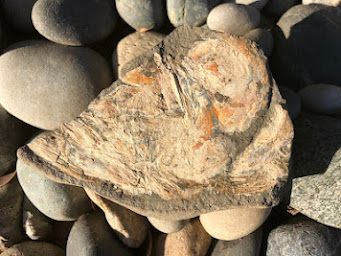 |
| Fossilized Salmon gifted to the Huntress by John Leahy |
It is also home to many rattlesnakes, so if you are up that way, step lively!
Among the most fascinating fossils found here are fossilized salmonids, distant ancestors of the modern Pacific salmon that are iconic to the rivers of British Columbia today.
The fossils of interest date back to the Eocene, approximately 50 million years ago, and are primarily found in the Tranquille Formation, a part of the Kamloops Group.
This ancient lakebed is located at McAbee Fossil Beds, near Cache Creek just west of Kamloops, and also in the nearby Driftwood Canyon and Princeton fossil beds, which together form part of British Columbia’s Eocene fossil record.
The Tranquille Formation preserves what was once a large, subtropical freshwater lake surrounded by lush forests.
Volcanic ashfalls and fine silt periodically buried aquatic organisms and plant matter, preserving them in astonishing detail. Among the insects, plants, and other fish fossils, paleontologists have discovered fossil remains of early salmonids, the group of fish that includes modern salmon and trout.
A significant discovery was Eosalmo driftwoodensis, the earliest known fossil representative of the salmon family (Salmonidae).
First described in 1977 by Canadian ichthyologist Mark Wilson, Eosalmo was recovered from the Driftwood Canyon site in northern BC but its relatives have been found in similar-aged formations across the province, including near Kamloops.
These fossils show that salmonids had already begun to diversify during the early Eocene. Eosalmo displays characteristics linking it to both trout and salmon, suggesting that the divergence between these lineages was already underway. Its morphology includes features like a terminal mouth, forked tail, and well-developed fins, hallmarks of active freshwater swimmers.
What’s particularly interesting about fossil salmonids in British Columbia is that they appear to have lived exclusively in freshwater during the Eocene.
This contrasts with today’s Pacific salmon, which are famously anadromous—born in freshwater, migrating to the ocean, and returning to spawn. The fossil record suggests this sea-run lifestyle evolved later, possibly as a response to tectonic shifts and changing ocean currents in the Miocene, around 20 million years ago.
The lakes of Eocene BC, including the one preserved at McAbee, would have supported thriving fish populations in a warm, relatively stable climate. Fossil finds include not just salmonids but also bowfins, suckers, and small freshwater herring-like fish, painting a picture of a rich and diverse aquatic ecosystem.
The McAbee Fossil Beds, now designated as a provincial heritage site, continue to yield new specimens. Though public access is currently restricted to protect the integrity of the site, ongoing research continues to uncover new details about the ancient ecosystems of interior BC.
Institutions such as the Royal BC Museum and the University of Alberta have studied and preserved these fossil fish. Scientific papers by Mark Wilson, and others have helped place these finds into a broader evolutionary context, revealing how ancient fish faunas of western North America evolved over tens of millions of years.
The fossil salmon of Kamloops bones, entombed in rock for 50 million years, speak to a time when the interior of British Columbia was lush, warm, and teeming with life.
As research continues, these fossil salmonids help illuminate the early history of a fish group vital not just to ecosystems, but to cultures and economies across the Pacific Rim.
The beauty you see here is a fossil salmon skull gifted to me by the remarkable John Leahy, who is much missed!
References:
Wilson, M. V. H. (1977). Eosalmo driftwoodensis, a new genus and species of fossil salmonid fish from the Eocene of British Columbia. Canadian Journal of Earth Sciences, 14(5), 1213–1230.
Wilson, M. V. H., & Li, G. Q. (1999). Osteology and phylogenetic relationships of Eosalmo, the earliest known salmonid fish. Canadian Journal of Earth Sciences, 36(10), 1559–1573.
Archibald, S. B., Greenwood, D. R., Smith, R. Y., Mathewes, R. W., & Basinger, J. F. (2011). Great Canadian Lagerstätten 1. Early Eocene Lagerstätten of the Okanagan Highlands (British Columbia and Washington State). Geoscience Canada, 38(4), 155–164.
McAbee Fossil Beds Provincial Heritage Site: https://www2.gov.bc.ca
If you’re ever driving through Kamloops, it’s humbling to think that beneath your feet lie the ancestors of today’s salmon—timeless travellers of BC’s ancient waterways.
